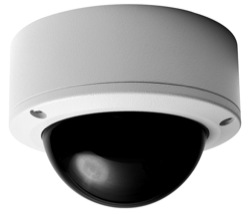Article written by Accu-Tech Regional Security Specialist Rick Stuart.

If you are looking to install a security surveillance system at your location, one of the decisions you have to make is whether to go with an IP or analog camera. Deciding on IP versus analog cameras is not necessarily a simple decision as there are advantages and disadvantages to each style of camera. We will explore some of these differences more in-depth so you can determine which option is right for you.
The main difference between the two camera types is the way in which the video signal is delivered. Analog cameras turn the images into a composite video signal that can be received by a television/monitor or recorded on a VCR or DVR (Digital Video Recorder). An IP-based camera, also known as an IP network camera, digitizes the video signal using a specialized encoder that contains an onboard web server. This allows the IP camera to act as a network device, thus allowing captured video images to be viewed not only through an existing network but also through a web browser that can be accessed through the Internet. IP cameras are recorded on a NVR (Network Video Recorder) which is attached to the network.
Both analog and IP-based video cameras can transmit signals either wirelessly or through wired connections such as Cat-5 cables. IP-based cameras have the added benefit of being able to use switches, hubs, routers, or even the internet to allow the network to be expanded to far-reaching locations. In order to determine which style camera system is best suited to your needs, let's take a closer look at some of the pros and cons of each style.
Pros of analog cameras
•Lower cost -- Analog cameras generally cost less to purchase than IP cameras.
•Greater flexibility of design -- Analog cameras often come in a larger variety of designs such as mini covert cameras to large PTZ models. If you have unique surveillance needs you may find it easier to find the style of camera you need in an analog model.
•Superior compatibility -- It is much easier to mix and match cameras and brands if you use analog versions. This can make it easier if you already have existing camera equipment that you wish to incorporate into your surveillance system.
Cons of analog cameras
•Lack certain features -- Many of the basic analog cameras often lack some of the more advance features such as digital zoom.
•Potential interference problems -- If you are installing a wireless surveillance system, analog systems can have interference problems. More importantly, the resulting signals cannot be encrypted. This can potentially mean that someone else can view the signal.
•Long distance applications are more difficult -- If your surveillance needs encompass a wide area, analog cameras may not be your best choice. Analog cameras generally do not accommodate big distances, and getting them to work over broad ranges can be difficult.
•Video signal conversion and transmission -- Analog cameras take the digital image that is captured and convert it to an analog signal in order to transmit it to the viewing/recording equipment where it is often then converted back to a digital format to be recorded. There is a reduction in quality due to this conversion process and the loss incurred in the transmission.
Pros of IP cameras
•Greater Resolution -- This is one of the most important advantages to IP cameras. Most have an image resolution that is a minimum of four times greater than that offered by analog cameras. HD images are possible with cameras that are able to deliver resolutions of 3, 5, 8 megapixel and beyond. This often allows one IP camera to take the place of several analog cameras and can have the effect of delivering a far superior product at a reduced cost.
•Better wireless reception -- IP cameras have encryption built right into them providing for a more secure network. Many options exist for transmission including point-to-point, point-to-multipoint, and mesh. Interference can be minimized with some IP-based radios.
•Can utilize existing wiring -- Because IP-based cameras act as their own network device, you can often take advantage of existing network wiring within your location. This can make the installation task much easier.
•Remote access can be easier -- IP cameras are better suited for some remote surveillance needs. There can be greater flexibility in how the video is accessed.
•Pure digital transmission -- Because the IP camera solution utilizes a digital format from capture to recording, there is no loss of quality in conversion or transmission as with an analog camera.
Cons of IP cameras
•Higher cost -- Because of the additional technology that is built into each camera, the cost of individual IP cameras is generally higher than analog versions. This gap is narrowing, however.
•Higher bandwidth required -- IP cameras will require bandwidth on your network that is not required with analog cameras. This can be reduced by taking advantage of some of the newer compression formats and technology that is available in the cameras.
Given the pros and cons of each camera type, the decision really comes down to your specific surveillance needs. The good news is, with products such as video encoders and hybrid recorders, analog and IP cameras can be combined within the same system to allow you to take advantage of both technologies. With an accurate assessment of your needs, the decision of which camera type to go with will become much easier
